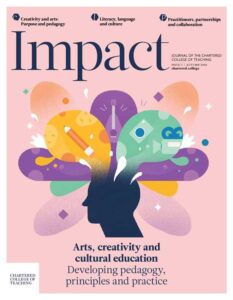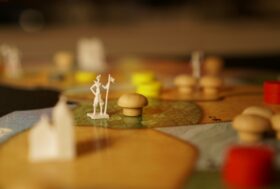Bringing arts back from the brink

To neglect the contribution of the arts in education, either through inadequate time, resources or poorly trained teachers, is to deny children access to one of the most stunning aspects of their culture and one of the most potent means for developing their minds.
Eisner,1987
Introduction
Thanks to the new direction of OfstedThe Office for Standards in Education, Children’s Services and Skills – a non-ministerial department responsible for inspecting and regulating services that care for children and young people, and services providing education and skills inspection, which refocuses education in England towards a broader and more balanced curriculum (Spielman, 2017; Hall, 2016), we now have hope that the tide is beginning to turn on the demise of learning in and through arts subjects in our primary schools. Let’s face it, we have possibly reached an all-time low in terms of time for arts participation during the school day, and in relation to funding of resources that might facilitate a rich experience for children in arts learning. Due to reduced opportunities in arts-based CPD for the workforce of primary teachers – and in the training of new teachers – skills and confidence in teaching arts subjects are also at a low, which, somewhere along the line, impacts negatively on the quality of offer in arts in primary schools. This article explores how we can start to redress this imbalance, by reminding ourselves that arts engagement is not only a human right, but is also a fundamental human need.
Hope springs
Despite repeated assurances from policy-makers that there has been no necessity for arts education to be reduced (Gibb, 2018), the statistics are now hard to argue with. The title of a recent report commissioned by the Fabian Society, ‘Primary colours: The decline of arts education in primary schools and how it can be reversed’ (Cooper, 2018), says it all, loud and very clear. This research has affirmed previous work undertaken by NSEAD (2016), which has shown that arts subjects have suffered further reductions in terms of teaching time and status within the last decade. Cooper’s project surveyed 401 primary teachers to ask about levels of quality, quantity and access to resources and support in arts subjects, as well as questioning how generalist teachers perceived their own skills and confidence to provide education in arts learning in their schools since the year 2010. The resounding voice from the participants and the evidence they present is that, in fact, at every point there is a reduction of provision and levels of confidence. There are reasons for this too, which I’m sure will come as no surprise: a narrowing of the curriculum and a performative culture that pervades our education system leave little wriggle room in the school day for subjects that we can’t measure. The EBacc, taken at age 16, does not include arts subjects, so many teenagers are giving up these areas of study at an early age to concentrate on the ones that are deemed to matter more. Some of these teenagers, whose educational experience has been narrow and focused on the ‘core’ subjects of English and maths, are now in our teacher training programmes, with little experience or understanding of why arts are important – or even necessary – and so the spiral potentially continues on a downward trend. Cooper’s report, however, gives us a way back. He purports that the decline can and must be reversed, which is where we must now put our collective energies.
Where do we begin?
Before we look at Cooper’s recommendations for halting the damage already in progress, it is important for us to revisit some of the fundamental benefits of arts education. A good place to start is to remind ourselves of the United Nations Convention on the Rights of the Child (1989), which states says that children are entitled to an education in which they can flourish as individuals (Article 29), and that they have the right to take part in wide range of cultural and artistic activities (Article 31).
It is key for us to reflect on this for a moment. Depending on factors such as socio-economic circumstances or hectic family schedules, for example, it is not automatically given that every child will have the opportunity to participate in arts, as is their right. For those children, therefore, school is the only place where they will have this exposure – the only place where they might discover their passion or their talent. And this is why we need to ensure that we offer a well-rounded and balanced curriculum, where children are shown new things, and encouraged to try new challenges, take risks, ask questions and explore their material and conceptual worlds without fear of failure or of being pre-judged.
The artist Bob and Roberta Smith campaigned against Michael Gove in the 2016 general elections with the slogan that ‘Art is a human right’. He also used his campaign to highlight the power of arts participation and creativity to develop children in a holistic way: to ‘give a voice to the voiceless’ (Smith, 2016)
We are, in fact, duty bound to provide learning in a wide range of subjects through the 2002 Education Act (Part 6:78, p. 53). This legally obliges us to:
(a) promote the spiritual, moral, cultural, mental and physical development of pupils at the school and of society, and (b) prepare pupils for the opportunities, responsibilities and experiences of later life.
This section of the Act is not possible to fulfil without a commitment to offering a broad and balanced curriculum – one that includes learning in and through the arts – a commitment that we have now been given permission to carry out by Ofsted. I would never advocate that compulsion to teach certain subjects is a good enough reason to ensure arts coverage in the primary curriculum, but the 2013 National Curriculum for state-maintained schools (Department for EducationThe ministerial department responsible for children’s services and education in England, 2013) also insists that arts provision is statutory. The guidance within the programmes of study for the subject areas of art and design and music, however, is less than helpful to the generalist teacher: the one-page document sends a message that these subjects are of minor importance, which could not be further from the truth.
Lessons the arts teach
We can look in a number of places to discover the potential and capacity of learning in and through the arts for developing children (and adults) in holistic ways, giving them physical, mental and emotional, intellectual and social skills and competencies – and this is nothing new (Read, 1943; Dewey, 1934). More recently, reports such as the APPG for Health and Wellbeing Inquiry report (2017) and the Warwick report (Neelands et al., 2015) highlight the key contribution to children’s lives that arts and cultural learning make to developing the whole child. Crossick and Kaszynska’s report (2016, p. 113) ‘Understanding the value of arts and culture’ notes that:
It may be more appropriate to see the importance of participation in the arts and art education as less about a simple set of generic or transferable skills, and more as contributing to the habits of mind that provide a platform needed for all learning: habits such as following curiosities and possibilities, a willingness to practice repeatedly, not taking things for granted and developing a strong inner critic.
Indeed, if this is correct, then, by teaching ‘habits of mind’ for life-long learning, the arts also serve as an antidote to a curriculum where ‘short-termism’, by being right all the time and passing tests well, risks seeming to be the main goal.
Elliot Eisner (2002) devised a ‘top ten’ list of reasons why arts education is essential for children to develop in holistic ways in which they can develop resilience and self-belief – to tune them in to their own humanity. He reasons that participation in arts enables students to learn in ways that are not possible in other subjects: to engage with materiality; to experience the sensory world; to find and solve problems; to understand ‘multiple perspectives’; to appreciate subtleties; to feel; and to give voice to things that cannot be said through words alone. The ten lessons can be accessed through the following website: https://www.arteducators.org/advocacy/articles/116-10-lessons-the-arts-teach
A principled pedagogy
We have established the value of arts participation – so we know the why. It is now time to turn our attention to the how. To do this, we have to consider what we expect children to learn – so the why and the how are intrinsically linked together. In order for children to develop the habits of mind for good learning, to develop creative dispositions that will allow them to solve problems of the future in imaginative ways, and to develop as well-rounded, thoughtful, compassionate and accomplished human beings, our pedagogical approach should reflect these values. It is therefore no good to give a child a paintbrush and paper and ask them to create something wonderful without any context; collective singing once a week will teach children very little about the concepts and joy of musical experimentation and discovery; tightly controlled PE lessons or sports coaching will not give children the freedom to express their ideas through movement and using their bodies. We can, however, look at examples of active and enquiry-based learning from around the world to inspire us. The acclaimed Reggio schools in northern Italy, for example, offer exactly this pedagogy by acknowledging the ‘hundred languages of children’ (Edwards et al., 1998), where every child is valued for the unique individual that they are within a community-based, collaborative paradigm, where curiosity and imagination are central and there are 100 ways to communicate their learning. Eisner, again, gives us five principles to underpin good learning in the arts, which we can reflect upon when planning arts experiences for children (2002, pp. 43–44):
Principle 1. In justifying its case, art education should give pride of place to what is distinctive about the arts.
Principle 2. Art education programmes should try to foster the growth of artistic intelligence.
Principle 3. Art education programmes should help students to learn how to create satisfying visual images, how to see and respond to what we call the arts and other visual forms, and how to understand the role the arts play in culture.
Principle 4. Art education should help students to recognise what is personal, distinctive, and even unique about themselves and their work.
Principle 5. Art education programmes should make special efforts to enable students to secure aesthetic forms of experience in everyday life.
The fight back
Finally, we should consider Cooper’s (2018) recommendations for reversing the decline in arts teaching and participation, which are largely directed towards policy-makers in terms of more funding required and a sea-change in government policy that would see arts prioritised in the National Curriculum. Whilst these suggestions might seem way out of our control, there are positive changes that we can and must make in our classrooms and in our primary schools. The recommendation that ‘No school should be judged “outstanding” unless it offers high-quality arts education as part of a broad and balanced curriculum, with high-quality arts education and cultural opportunities for all pupils’ (Cooper, 2018, p. 18) could be the thing that persuades school leaders to review their current offer, especially as we know that Ofsted are warm to this. With deeper understanding of the value that the arts bring to the lives of children, and of our role in providing a learning environment that is underpinned by curiosity and imagination, we might reflect upon our own practice to ensure that children’s rights to accessing learning in the arts, through a broad and balanced education, are upheld.
References
APPG for Arts Health and Wellbeing (2017) Creative health: The arts for health and wellbeing. Inquiry report. Available at: www.artshealthandwellbeing.org.uk/appg-inquiry (accessed 2 August 2019).
Cooper B (2018) Primary colours: The decline of arts education in primary schools and how it can be reversed. London: Fabian Society. Available at: https://fabians.org.uk/wp-content/uploads/2019/01/FS-Primary-Colours-Report-WEB-FINAL.pdf (accessed 2 August 2019).
Crossick G and Kaszynska P (2016) Understanding the value of art and culture. Wiltshire: AHRC. Available at: www.ahrc.ac.uk/documents/publications/cultural-value-project-final-report (accessed 2 August 2019).
Department for Education (2013) The National Curriculum in England: Key Stages 1 and 2 framework document. Available at: www.gov.uk/government/publications/national-curriculum-in-england-primary-curriculum (accessed 2 August 2019).
Dewey J (1934) Art as Experience. New York: Penguin Putnam.
Edwards C, Gandini L and Forman G (1998) The Hundred Languages of Children, The Reggio Emilia Approach: Advanced Reflections. London: Ablex.
Eisner E (1987) Educating the Whole Person: Arts in the Curriculum. Music Educators Journal 73(8): 37-41. Available at: http://www.jstor.org/stable/3400241 (accessed 5 August 2019).
Gibb N (2018) Education Select committee (accountability hearings): 22 May 2018. Available at: https://parliamentlive.tv/event/index/169c341d-e8bc-44de-ab49-2482bfc6acc4 (accessed 2 August 2019).
Hall J (2016) A broad and balanced curriculum: Key findings from Ofsted. Available at: www.insidegovernment.co.uk/uploads/2016/09/joannahall-1.pdf (accessed 2 August 2019).
Neelands J, Belfiore E, Firth C et al. (2015) Enriching Britain: Culture, creativity and growth. University of Warwick: The Warwick Commission. Available at: https://warwick.ac.uk/research/warwickcommission/futureculture/finalreport/ (accessed 2 August 2019).
NSEAD (National Society for Education in Art and Design) (2016) Survey report 2015–16. Available at: nsead.org/downloads/survey.pdf (accessed 11 October 2016).
Read H (1943) Education Through Art London: Faber.
Smith B and Smith R (2016) Art gives a voice to the voiceless, TEDx, London: Courtauld Institute. Available at: https://bit.ly/2Yp6TC2 (accessed 5 August 2019).
Spielman A (2017) HMCI’s commentary: Recent primary and secondary curriculum research. Available at: www.gov.uk/government/speeches/hmcis-commentary-october-2017 (accessed 2 August 2019).
United Nations (1989) Convention on the Rights of the Child, CRC, United Nations General Assembly. Available at: www.ohchr.org/en/professionalinterest/pages/crc.aspx (accessed 2 August 2019).
This article was published in September 2019 and reflects the terminology and understanding of research and evidence in use at the time. Some terms and conclusions may no longer align with current standards. We encourage readers to approach the content with an understanding of this context.










